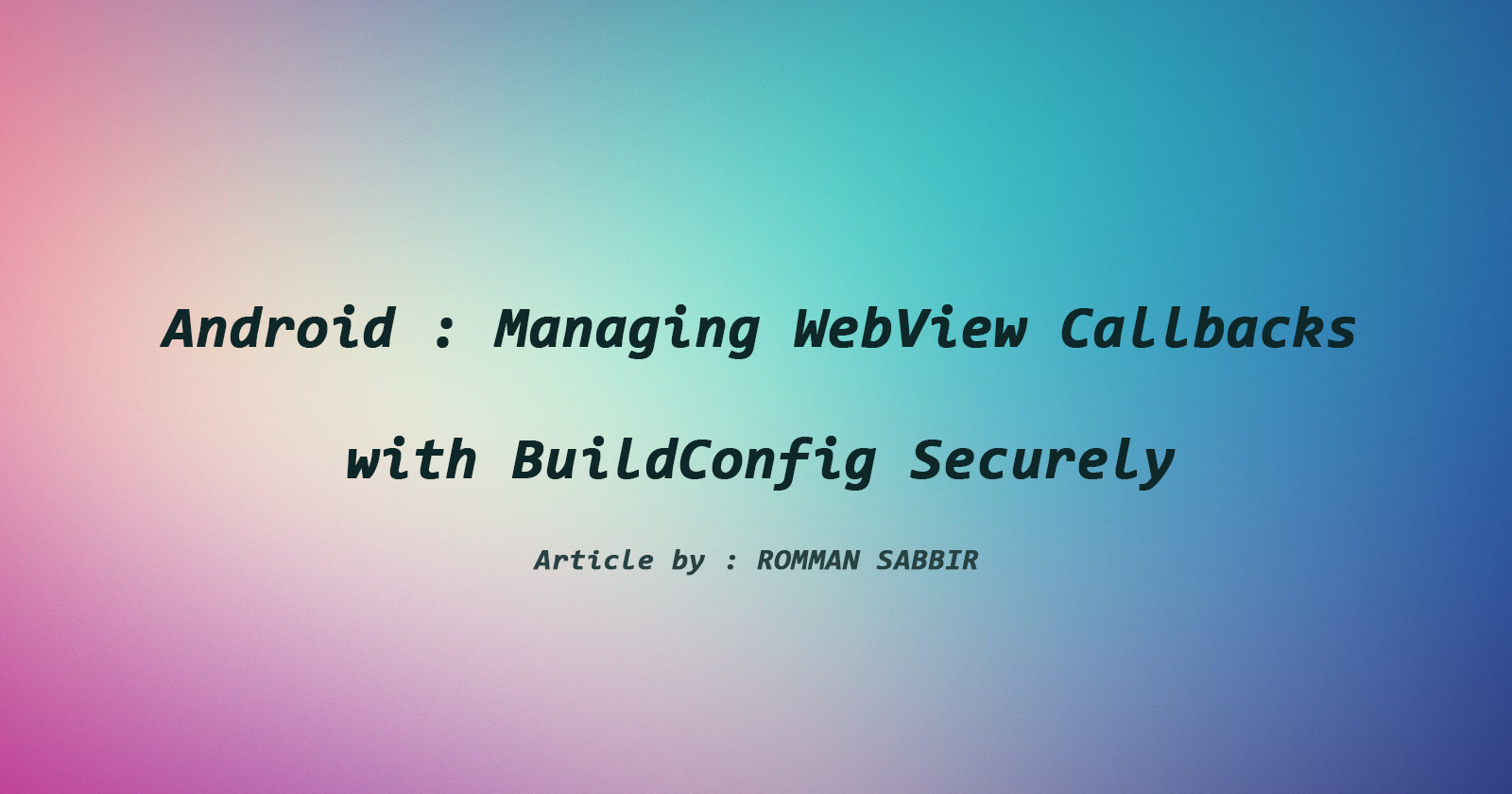Android : Managing WebView Callbacks with BuildConfig Securely.
 Romman Sabbir
Romman Sabbir
In Android development, buildConfigField is a powerful tool for defining constants at build time. It allows developers to embed configuration values directly into the generated BuildConfig class, making them accessible throughout the application code. One common scenario where buildConfigField is invaluable is in managing WebView callbacks, especially for tasks like payment verification, order processing, or any other critical operations involving web interactions.
Scenario: Managing WebView Callbacks
WebView is often used in Android apps to show web content, like payment forms, order confirmations, or any interaction needing secure verification. Handling callbacks from WebView means making sure the callback URLs are trusted and processed securely within the app.
Understanding buildConfigField
Before we look at practical examples, let's understand how buildConfigField works:
Definition:
buildConfigFieldis set up in ourbuild.gradlefile inside theandroidblock. It lets us define constants of different types (String,boolean,int, etc.) that are added to your app'sBuildConfigclass during the build process.Usage: Constants defined with
buildConfigFieldcan be accessed through theBuildConfigclass in our Kotlin or Java code. They allow us to customize our app based on build flavors, build types, or specific settings.
Step-by-Step Guide
Let’s go through how to use buildConfigField to manage callback URLs securely in our Android app:
1. Define Callback URLs inbuild.gradle :
First, define the callback URLs as a String field in our build.gradle file. For example:
android {
...
buildTypes {
release {
buildConfigField("String", "PAYMENT_CALLBACK_URL", "\"https://yourdomain.com/payment/callback\"")
buildConfigField("String", "ORDER_CALLBACK_URL", "\"https://yourdomain.com/order/callback\"")
// Define other callback URLs as needed
}
debug {
buildConfigField("String", "PAYMENT_CALLBACK_URL", "\"https://dev.yourdomain.com/payment/callback\"")
buildConfigField("String", "ORDER_CALLBACK_URL", "\"https://dev.yourdomain.com/order/callback\"")
// Define other debug callback URLs as needed
}
}
}
In this example:
PAYMENT_CALLBACK_URLandORDER_CALLBACK_URLare set with different values forreleaseanddebugbuild types. Change these URLs based on our environment (production, staging, development, etc.).
2. Accessing Callback URLs in Kotlin Code:
Next, access these callback URLs from our Kotlin code, such as in an Activity or a ViewModel:
val paymentCallbackUrl = BuildConfig.PAYMENT_CALLBACK_URL
val orderCallbackUrl = BuildConfig.ORDER_CALLBACK_URL
// Access other callback URLs as needed
3.WebViewIntegration:
Integrate WebView in our app to handle loading and navigation events. Make sure that when WebView loads a URL, we check if it matches any of the allowed callback URLs defined in BuildConfig.
webView.webViewClient = object : WebViewClient() {
override fun shouldOverrideUrlLoading(view: WebView?, request: WebResourceRequest?): Boolean {
val url = request?.url.toString()
// Check if the URL matches any of the allowed callback URLs
if (url == paymentCallbackUrl) {
// Handle payment confirmation logic
// Example: Update payment status in our app
return true // Consumes the URL, prevents WebView from loading it
} else if (url == orderCallbackUrl) {
// Handle order confirmation logic
// Example: Update order status in our app
return true // Consumes the URL, prevents WebView from loading it
}
// For other URLs, allow WebView to load normally
return false
}
}
4. Enhancing Security and Maintenance:
Security: By using
buildConfigFieldto define callback URLs, we manage them in one place and ensure they are included in our app during the build process. This lowers the risk of hardcoding sensitive URLs directly in our code.Maintenance: We can easily update callback URLs for different environments (e.g., production, staging) by changing
build.gradlewithout altering your app’s code.
5. Error Handling and Edge Cases:
Implement strong error handling for situations where unexpected URLs are loaded in
WebView.We have to think about edge cases like network failures, server timeouts, and user interruptions during
WebViewinteractions.
Conclusion
Using buildConfigField in Android apps, especially for managing WebView callbacks, boosts security, simplifies maintenance, and adds flexibility for different build setups. By setting callback URLs as build configuration fields, developers can securely manage payment verification, order confirmations, and other important tasks involving WebView.This method makes development easier and improves the reliability and security of WebView integrations in our Android app.
That's it for today. Happy Coding...
Subscribe to my newsletter
Read articles from Romman Sabbir directly inside your inbox. Subscribe to the newsletter, and don't miss out.
Written by

Romman Sabbir
Romman Sabbir
Senior Android Engineer from Bangladesh. Love to contribute in Open-Source. Indie Music Producer.